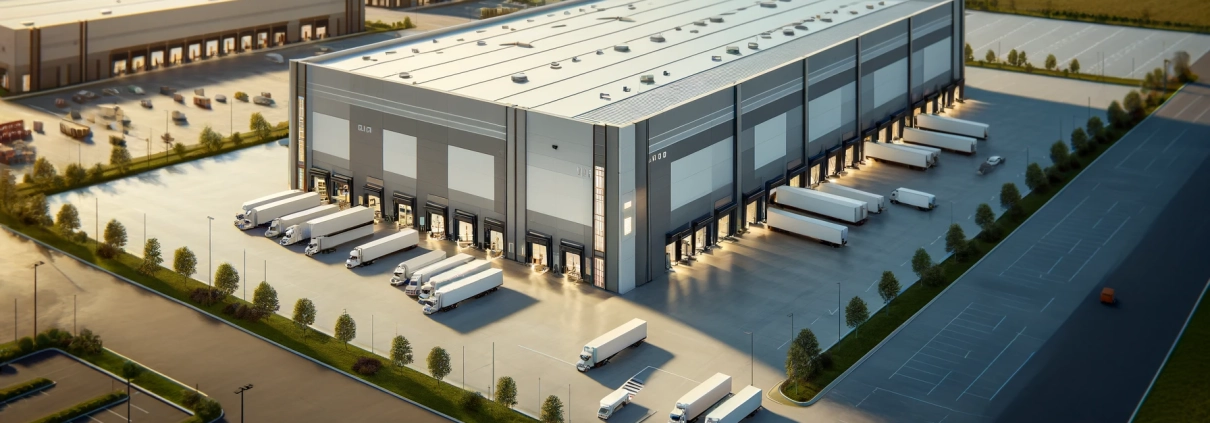Warehouse
Warehouse is a sub-type of the Industrial Property Type in commercial real estate used primarily for the storage and distribution of goods. These properties are typically one-story buildings with high ceilings to maximize vertical storage space.
They are characterized by their functional design, which includes high ceilings, multiple dock high doors, minimal office space, appropriate floor load capacity, and standardized column spacing. They are designed to allow for the efficient storage and movement of goods directly in and out of the warehouse.
- High Ceilings (Clear Height): Warehouses generally have ceilings that are at least 24 feet high, facilitating the use of tall storage racks that maximize space efficiency.
- Dock High Doors: These doors are elevated to the height of the truck bed, ensuring easy and efficient loading and unloading of goods. Warehouses often feature a large number of these doors to accommodate simultaneous shipments.
- Office Space: A smaller portion of the warehouse might be dedicated to office space, where administrative tasks related to logistics and operations are managed. This area supports the overall functionality of the warehouse by coordinating operations, handling logistics, and managing staff.
- Floor Load Capacity: Warehouses are designed with floors that can withstand heavy loads, which is critical for storing large quantities of goods and operating heavy machinery like forklifts.
- Loading Configurations: Warehouses vary in loading configurations such as rear load, which focuses on truck access at the rear, and cross dock, facilitating goods movement from one side to another, optimizing operational flow.
- Accessibility: Located strategically to optimize logistics and distribution networks, warehouses often have excellent connectivity to major highways, ports, and railroads.
Understanding the strategic role of warehouses in the supply chain helps understand their importance. They serve as critical hubs that facilitate the efficient distribution of goods globally, regionally, and locally, ensuring that products move seamlessly from manufacturers to retailers and finally to consumers.
Putting ‘Warehouse’ in Context
Scenario:
Imagine “Midwest Distribution Hub,” a newly developed warehouse located in the western suburbs of the Chicago MSA. This facility spans 200,000 square feet, primarily designed to cater to third-party logistics (3PL) and distribution companies specializing in e-commerce fulfillment.
Project Description:
Midwest Distribution Hub features a modern design with a 32-foot clear height ceiling to accommodate high-stacking storage systems. The warehouse includes 40 dock high doors, ensuring efficient movement of goods and 24/7 operational capabilities. About 10,000 square feet of the facility is dedicated to office space, housing management, administrative staff, and a control center for logistics operations.
Warehouse Utilization:
The main area of the warehouse is used for storing a wide variety of consumer goods, ranging from electronics to packaged apparel. An advanced inventory management system is integrated to streamline the process of item retrieval, sorting, and shipping. The layout is optimized for both manual and automated handling methods, featuring wide aisles and designated zones for sorting and packaging.
Operational Dynamics:
Midwest Distribution Hub operates as a critical node in the supply chain of several large e-commerce companies. It utilizes its office component for strategic planning, real-time inventory tracking, and customer service operations. The efficiency of loading and unloading is maximized through the use of telescopic conveyor systems at each dock high door, significantly reducing turnaround times for inbound and outbound trucks.
This scenario is hypothetical and serves to illustrate the functionality and strategic importance of a modern warehouse in the logistics and e-commerce sectors.
Frequently Asked Questions about Warehouses in Commercial Real Estate
What is a warehouse in commercial real estate?
A warehouse is a subtype of industrial property “used primarily for the storage and distribution of goods.” These are typically one-story buildings with functional features like high ceilings, dock high doors, and minimal office space.
What are the key physical features of a warehouse?
Common features include “high ceilings (typically at least 24 feet), multiple dock high doors, minimal office space, high floor load capacity, and standardized column spacing.”
How is office space integrated into a warehouse facility?
Warehouses often dedicate a “smaller portion” of their footprint to office space used for “administrative tasks related to logistics and operations,” as seen in the 10,000 square feet used at Midwest Distribution Hub.
What is the purpose of dock high doors in warehouses?
Dock high doors are “elevated to the height of the truck bed,” allowing for efficient loading and unloading. Midwest Distribution Hub, for example, features 40 such doors.
How do warehouses support the supply chain?
Warehouses serve as “critical hubs that facilitate the efficient distribution of goods globally, regionally, and locally,” ensuring products move from manufacturers to retailers and consumers.
What is clear height and why is it important in a warehouse?
Clear height refers to the usable vertical space inside a warehouse. A height of “at least 24 feet” is standard, with Midwest Distribution Hub offering 32 feet to support “high-stacking storage systems.”
How does warehouse design affect operational efficiency?
Design features like “wide aisles, telescopic conveyor systems, and dock high doors” improve item retrieval, reduce truck turnaround time, and enhance logistical efficiency.
What is the role of location in warehouse operations?
Warehouses are “strategically located” near highways, ports, and railways to optimize connectivity and support efficient logistics and distribution networks.
Click here to get this CRE Glossary in an eBook (PDF) format.

